sensor AUDI TT 2013 Owner´s Manual
[x] Cancel search | Manufacturer: AUDI, Model Year: 2013, Model line: TT, Model: AUDI TT 2013Pages: 262, PDF Size: 65.91 MB
Page 81 of 262
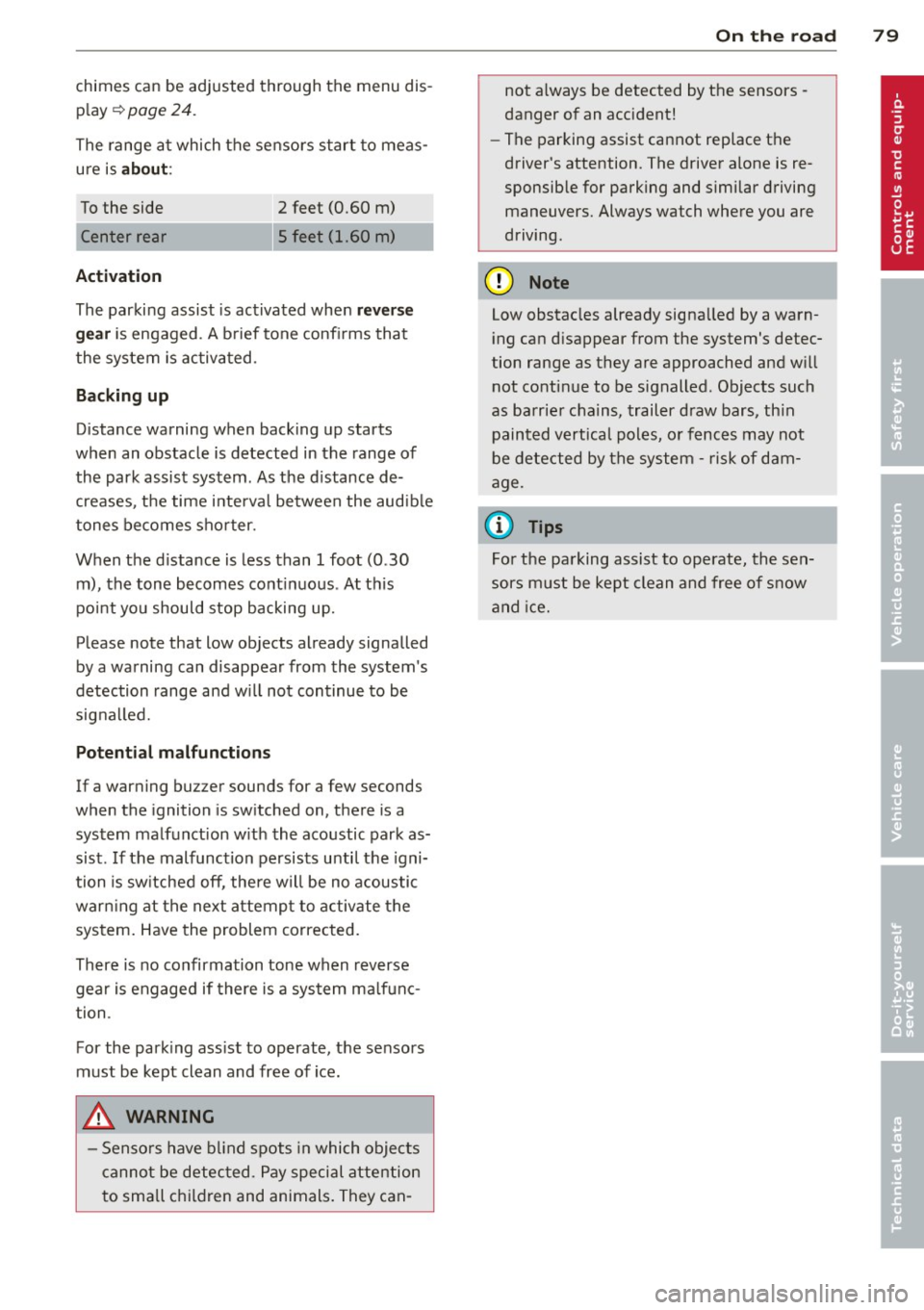
chimes can be adjusted through the menu disp lay ~
page 24 .
The range a t which the sensors start to meas
ure is
about :
To the side
Center rear
Activation
2 feet (0.60 m)
5 feet (1.60 m)
The parking assist is activated when
r ev erse
g ear
is engaged . A b rief tone confi rms that
the system is activated .
Bac king up
Distance warning when backing up starts
when an obstacle is detected in the range of
the park assist system . As the d istance de
creases, the time interva l between the audib le
tones becomes sho rter.
When the d istance is less than 1 foot (0 .30
m), the tone becomes cont inuous . At this
point you should stop backing up.
Please note that low objects already signalled
by a warning can disappear from the system's
detection range and w ill not continue to be
signalled.
Potential malfunction s
If a warning buzzer sounds for a few seconds
when the ignition is sw itched on, there is a
system malfunction w ith the aco ustic park as
sist . If the malfunction persists unti l the igni
tion is sw itched off , there will be no acoustic
warn ing at the next attemp t to activate the
system . Have the problem corrected.
Th ere is no confirmation tone when reverse
gear is engaged if there is a system ma lfun c
tion .
For the park ing ass ist to operate, the sensors
must be kept clean and free of ice .
.8, WARNING
- Senso rs have b lind spots in which obje cts
cannot be detec ted . Pay speci al atten tio n
to small c hildren and animals. They can-
On th e ro ad 79
not always be detected by the sensors -
danger of an accident!
- The parking assist cannot replace the
driver's attention. The driver alone is re
sponsib le for parking and similar driving
maneuvers. Always watch where you are
driving .
(D Note
Low obstacles already signa lled by a warn
i ng can d isappear from the system's detec
tion range as they are approached and w ill
not continue to be signalled . Objects such
as ba rrie r cha ins, trailer d raw bars, th in
painted vertica l poles, o r fences may not
be dete cted by the system -risk of dam
age.
(D Tips
F o r the pa rking assist to operate, the sen
sors m ust be kept clean and free of snow
a nd ice.
Page 108 of 262
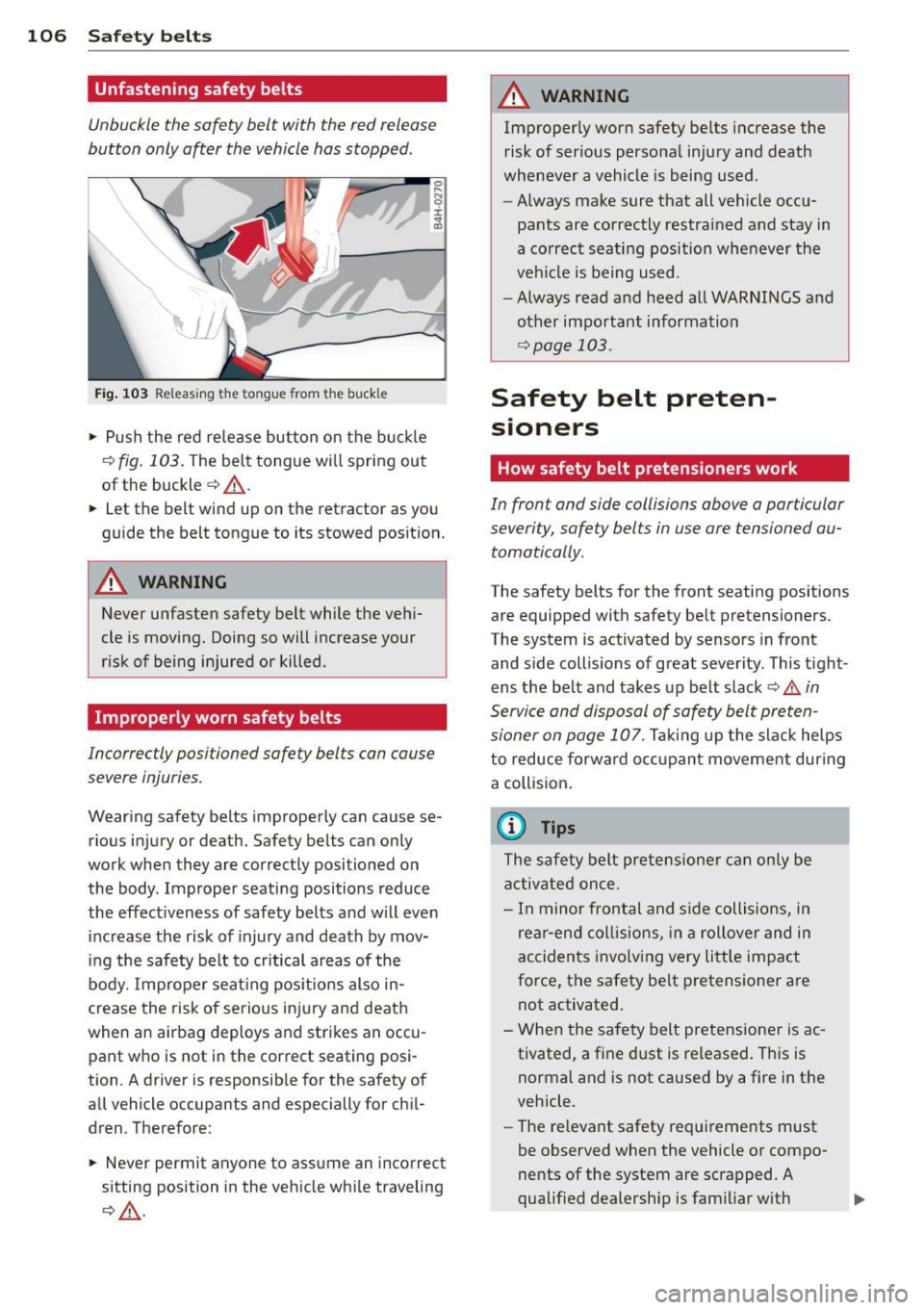
106 Safety belts
Unfastening safety belts
Unbuckle the safety belt with the red release
button only after the vehicle has stopped .
Fig. 103 Releasing the tongue from the buckle
• Push the red release button on the buckle
c> fig. 103. The belt tongue will spring out
of the buckle ~
,A.
0 r-N 0 ±.
"' a,
• Let the belt wind up on the retractor as you
guide the belt tongue to its stowed position.
A WARNING
Never unfasten safety belt while the vehi
cle is moving . Doing so will increase your
r isk of being injured or killed .
Improperly worn safety belts
Incorrectly positioned safety belts can cause
severe injuries.
Wearing safety belts improperly can cause se
rious injury or death. Safety belts can only
work when they are correctly positioned on the body . Improper seating positions reduce
the effectiveness of safety belts and will even
increase the risk of injury and death by mov
ing the safety belt to critical areas of the
body. Improper seating positions also in
crease the risk of serious injury and death
when an airbag deploys and strikes an occu
pant who is not in the correct seating posi
tion . A driver is responsible for the safety of
all vehicle occupants and especially for chil
dren. Therefore:
• Never permit anyone to assume an incorrect
sitting position in the vehicle while traveling
c>,&. .
A WARNING
-Improperly worn safety belts increase the
risk of ser ious personal injury and death
whenever a vehicle is being used.
- Always make sure that all vehicle occu
pants are correctly restrained and stay in
a correct seating position whenever the
veh icle is being used.
- Always read and heed all WARNINGS and
other important information
~ page 103.
Safety belt preten
sioners
How safety belt pretensioners work
In front and side collisions above a particular
severity, safety belts in use are tensioned au
tomatically .
The safety belts for the front seating positions
are equipped with safety belt pretensioners .
The system is activated by sensors in front
and side collisions of great severity. This tight
ens the belt and takes up belt slack
c> .&. in
Service and disposal of safety belt preten
sioner on page 107.
Taking up the slack helps
to reduce forward occupant movement during
a collision.
(D Tips
The safety belt pretensioner can only be
activated once .
- In minor frontal and side collisions, in
rear -end collisions, in a rollover and in
accidents involving very little impact
force, the safety belt pretensioner are
not activated.
- When the safety belt pretensioner is ac
tivated, a fine dust is released. This is normal and is not caused by a fire in the
vehicle.
- The relevant safety requirements must
be observed when the vehicle or compo
nents of the system are scrapped. A
qualified dealership is familiar with
II>
Page 117 of 262
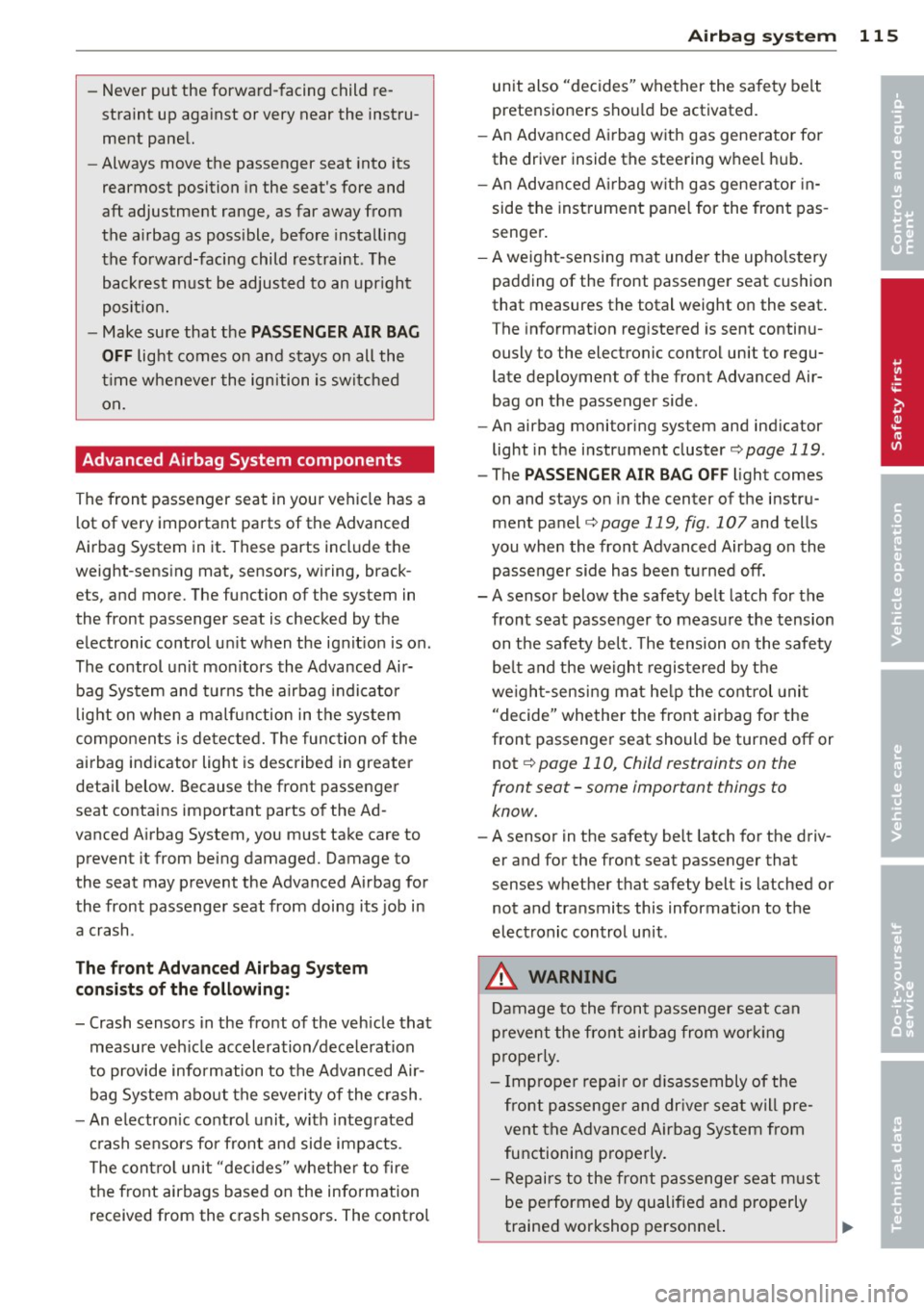
-Never put the forward-facing child re
straint up against or very near the instru
ment panel.
- Always move the passenger seat into its
rearmost position in the seat's fore and
aft adjustment range, as far away from
the airbag as possible, before installing
the forward-facing child restraint . The
backrest must be adjusted to an upright
position.
- Make sure that the
PASSENGER AIR BAG
OFF
light comes on and stays on all the
time whenever the ignition is switched
on.
Advanced Airbag System components
The front passenger seat in your vehicle has a
lo t of very important parts of the Advanced
Airbag System in it. These parts include the
weight-sens ing mat, sensors, wiring, brack
ets, and more. The function of the system in
the front passenger seat is checked by the
electronic control unit when the ignition is on.
The control unit monitors the Advanced Air
bag System and turns the airbag indicator
light on when a malfunction in the system
components is detected. The function of the
airbag indicator light is described in greater
detail below. Because the front passenger
seat contains important parts of the Ad
vanced Airbag System, you must take care to
prevent it from being damaged. Damage to
the seat may prevent the Advanced Airbag for
the front passenger seat from doing its job in
a crash .
The front Advanced Airbag System
consists of the following:
- Crash sensors in the front of the vehicle that
measure vehicle acceleration/deceleration
to provide information to the Advanced Air
bag System about the severity of the crash.
-An electronic control unit, with integrated
crash sensors for front and side impacts .
The control unit "decides" whether to fire
the front airbags based on the information
r eceived from the crash sensors. The control
Airbag system 115
unit also "decides" whether the safety belt
pretensioners should be activated.
- An Advanced Airbag with gas generator for
the driver inside the steering wheel hub.
- An Advanced Airbag with gas generator in
side the instrument panel for the front pas
senger.
- A weight-sensing mat under the upholstery
padding of the front passenger seat cushion
that measures the total weight on the seat.
The inform ation registered is sent continu
ously to the electronic control unit to regu
late deployment of the front Advanced Air
bag on the passenger side.
- An airbag monitoring system and indicator
light in the instrument cluster
c:;. page 119.
-The PASSENGER AIR BAG OFF light comes
on and stays on in the center of the instru
ment panel
c:;. page 119, fig. 107 and tells
you when the front Advanced Airbag on the
passenger side has been turned off.
- A sensor below the safety belt latch for the
front seat passenger to measure the tension
on the safety belt. The tension on the safety
belt and the weight registered by the
weight-sensing mat help the control unit
"decide" whether the front airbag for the
front passenger seat should be turned off or
not
c:;. page 110, Child restraints on the
front seat -some important things to
know.
- A sensor in the safety belt latch for the driv
er and for the front seat passenger that
senses whether that safety belt is latched or
not and transmits this information to the
electronic control unit .
.&_ WARNING
Damage to the front passenger seat can
prevent the front airbag from working
properly.
- Improper repair or disassembly of the
front passenger and driver seat will pre
vent the Advanced Airbag System from
functioning properly.
- Repairs to the front passenger seat must
be performed by qualified and properly
-
trained workshop personnel. 111>
•
•
Page 118 of 262
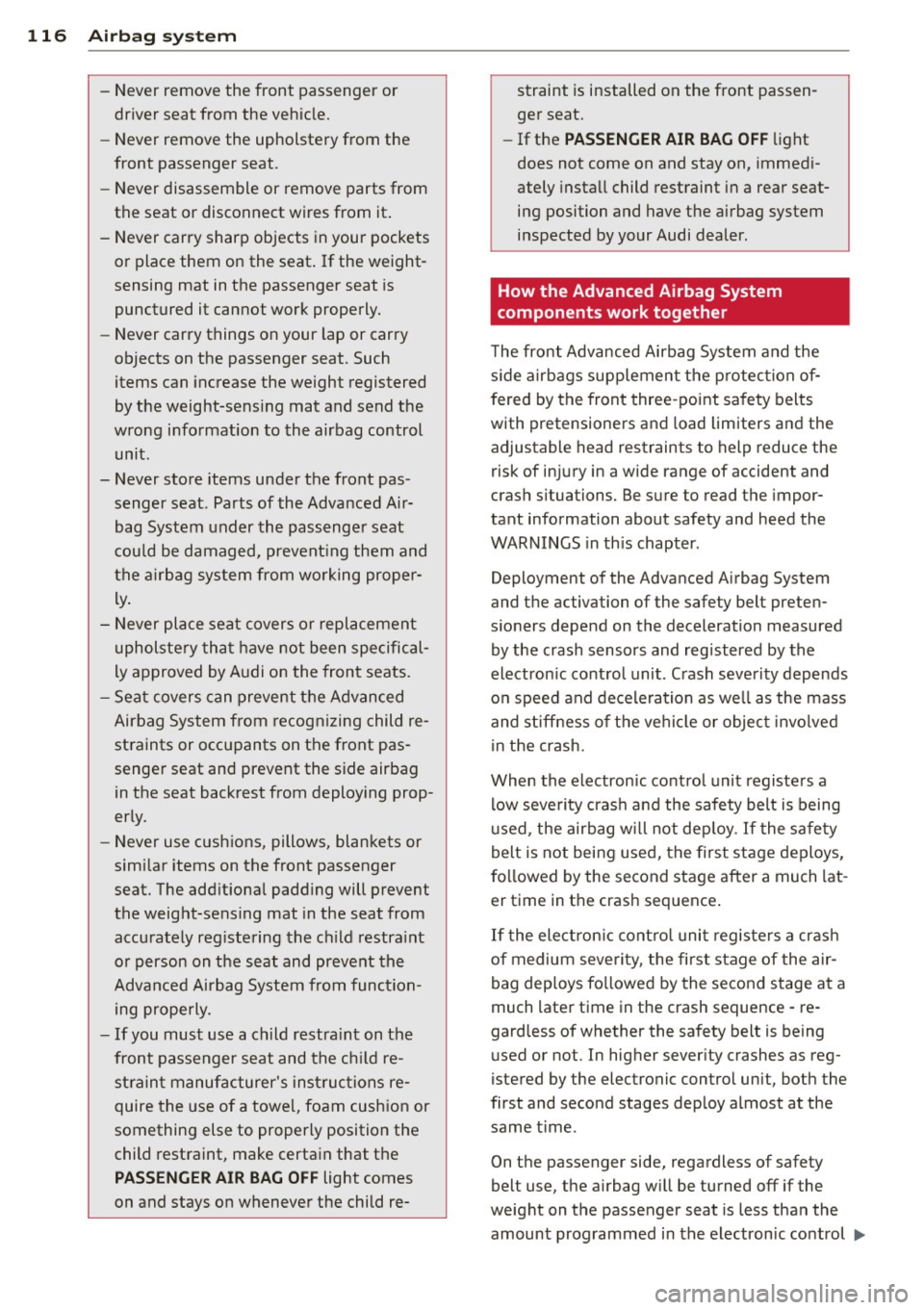
116 Airbag system
-Never remove the front passenger or
driver seat from the vehicle.
- Never remove the upholstery from the
front passenger seat.
- Never disassemble or remove parts from
the seat or disconnect wires from it.
- Never carry sharp objects in your pockets
or place them on the seat. If the weight
sensing mat in the passenger seat is
punctured it cannot work properly.
- Never carry things on your lap or carry
objects on the passenger seat. Such
items can increase the weight registered
by the weight-sensing mat and send the
wrong information to the airbag control unit.
- Never store items under the front pas
senger seat. Parts of the Advanced Air bag System under the passenger seat
could be damaged, preventing them and
the airbag system from working proper
ly.
- Never place seat covers or replacement
upholstery that have not been specifical
ly approved by Audi on the front seats.
- Seat covers can prevent the Advanced
Airbag System from recognizing child re
straints or occupants on the front pas
senger seat and prevent the side airbag
in the seat backrest from deploying prop
erly.
- Never use cushions, pillows, blankets or
similar items on the front passenger
seat. The additional padding will prevent
the weight-sensing mat in the seat from
accurately registering the child restraint
or person on the seat and prevent the
Advanced Airbag System from function
ing properly.
- If you must use a child restraint on the
front passenger seat and the child re
straint manufacturer's instructions re
quire the use of a towel, foam cushion or
something else to properly position the
child restraint, make certain that the
PASSENGER AIR BAG OFF light comes
on and stays on whenever the child re- straint is installed on the front passen
ger seat.
- If the
PASSENGER AIR BAG OFF light
does not come on and stay on, immedi
ately install child restraint in a rear seat
ing position and have the airbag system
inspected by your Audi dealer.
How the Advanced Airbag System
components work together
The front Advanced Airbag System and the
side airbags supplement the protection of
fer ed by the front three-point safety belts
with pretensioners and load limiters and the
adjustable head restraints to help reduce the
risk of injury in a wide range of accident and
crash situations. Be sure to read the impor
tant information about safety and heed the
WARNINGS in this chapter.
Deployment of the Adv a need Airbag System
and the activation of the safety belt preten
s ioners depend on the deceleration measured
by the crash sensors and registered by the
electronic control unit. Crash severity depends
on speed and deceleration as well as the mass
and stiffness of the vehicle or object involved
in the crash.
When the electronic control unit registers a low severity crash and the safety belt is being
used , the airbag will not deploy.
If the safety
belt is not being used, the first stage deploys,
follow ed by the second stage after a much lat
er time in t he crash sequence.
If the electronic control unit registers a crash
of medium severity, the first stage of the air
bag deploys followed by the second stage at a
much later time in the crash sequence -re
gardless of whether the safety belt is being
u sed or not . In higher severity crashes as reg
istered by the electronic control unit, both the
first and second stages deploy almost at the
same time.
On the passenger side, regardless of safety
belt use, the airbag will be turned off if the
weight on the passenger seat is less than the
amount programmed in the electronic control
Ill-
Page 121 of 262
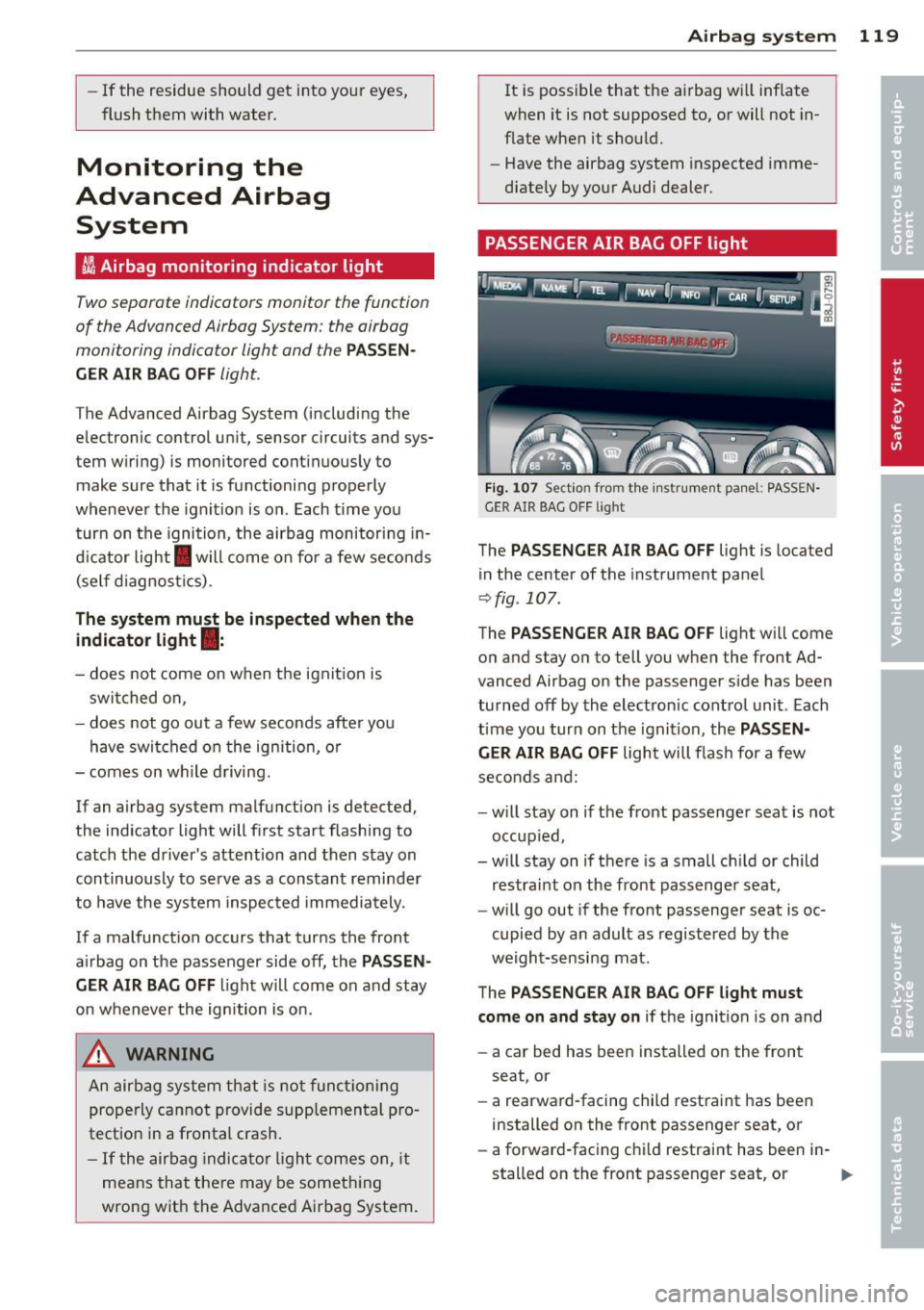
-If the residue should get into your eyes,
flush them with water.
Monitoring the
Advanced Airbag System
~ Airbag monitoring indicator light
Two separate indicators monitor the function
of the Advanced Airbag System : the airbag
monitoring indicator light and the
P ASS EN
GER AIR BA G OFF
light .
The Advanced Airbag System (including the
electronic control un it, sensor circuits and sys
tem wiring) is monitored continuously to make sure that it is functioni ng properly
whenever the ignit ion is on . Each time you
turn on the ignition , the airbag monitoring in
d icator light
I will come on fo r a few seconds
(self diagnos tics) .
The system mu st be inspect ed when the
indicator light
I :
- does not come on when the ignit ion is
switched on,
- does not go out a few seconds after you
have switched on the ignition, o r
- comes on wh ile driving .
If an airbag system malfunction is detected,
the indicator light will first start flashing to
catch the driver's attention and then stay on
continuously to serve as a constant reminder
to have the system inspected immediately.
If a malfunction occurs that tur ns the front
a irbag on the passenger side off, the
P A SSEN
GER AIR BAG OFF
li ght will come on and stay
on whenever the ignition is on.
_& WARNING
An airbag system that is not funct ioning
properly cannot provide supp lemental pro
tection in a frontal crash .
- If the airbag indica tor light comes on, it
means that there may be someth ing
wrong wit h the Advanced Ai rbag System.
-
A irba g sy stem 119
It is possible that the airbag wi ll inflate
when it is not supposed to, or will not in
flate when it should.
- Have the airbag system inspected imme
diate ly by your Audi dealer.
PASSENGER AIR BAG OFF light
F ig . 107 Sect io n fro m t he in str ument pa nel: PASSEN
GER AIR BAG O FF lig ht
The PAS SENGER AIR BAG OFF light is located
in the center of the instrument panel
~ fig . 107 .
The PASS ENGER AIR BAG OFF light will come
on and stay on to tell you when the front Ad
vanced Airbag on the passenger s ide has been
turned off by the electron ic control unit . Each
t ime you turn on the ignit ion , the
PA SS EN
GER A IR BAG OFF
light will f lash for a few
seco nds and:
- will stay on if the front passenger seat is not
occup ied,
- w ill stay on if the re is a small ch ild or child
restrai nt on the front passenger seat,
- will go out if the front passenger seat is oc
cupied by an adult as registered by the
we ight-sensing mat .
The
PAS SENGER AIR BAG OFF l ight must
come on and sta y on
if the ignition is on and
- a car bed has been installed on the front
seat, or
- a rearward-facing child restraint has been
installed on the front passenger seat, or
- a forward-facing chi ld restraint has been in-
stalled on the front passenger seat, or ..,.
Page 122 of 262
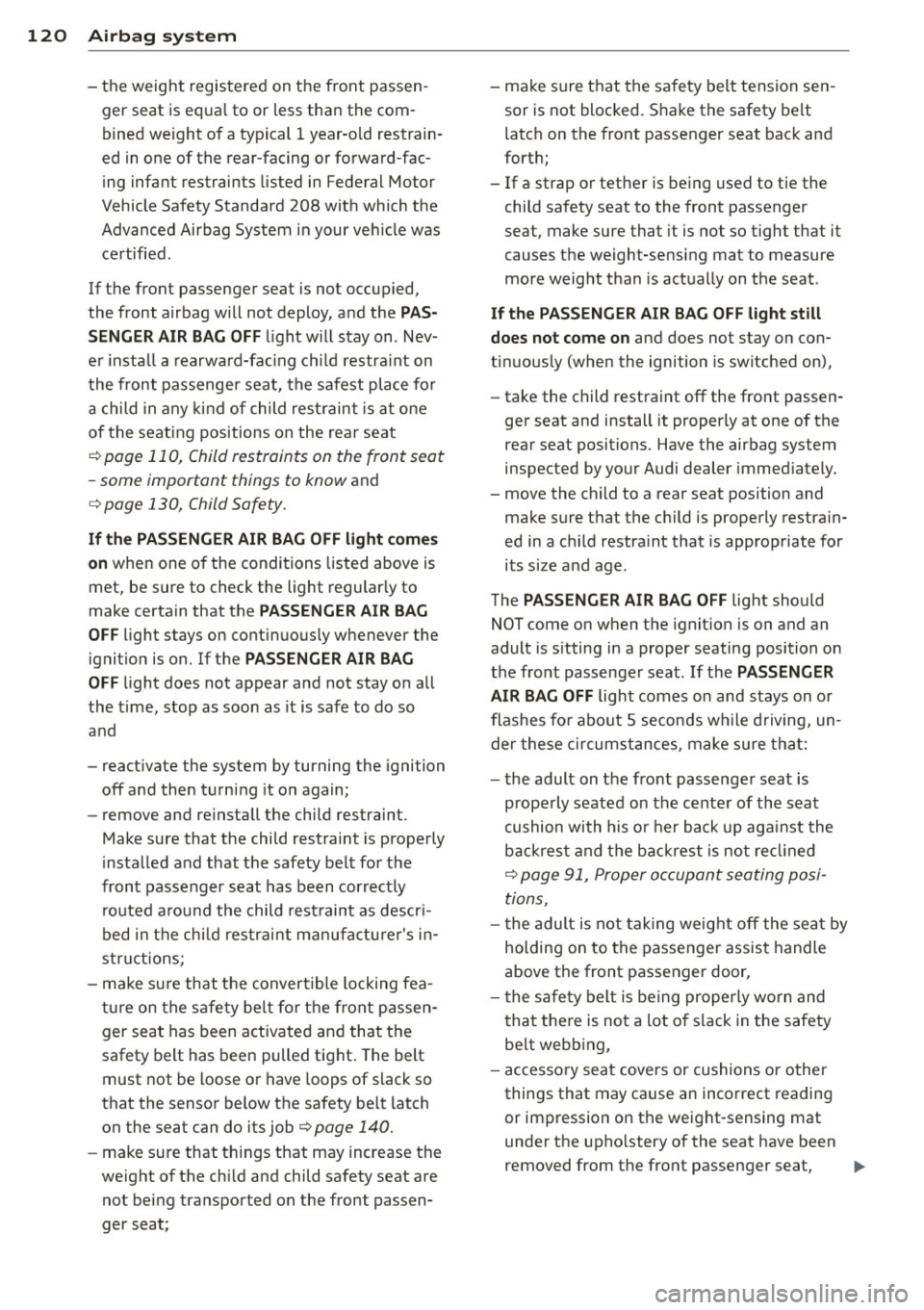
120 Airbag system
- the weight registered on the front passen
ger seat is equa l to or less than the com
bined weight of a typical 1 year-old restrain
ed in one of the rear-facing or forward-fac
ing infant restraints listed in Federal Motor
Vehicle Safety Standard 208 with which the
Advanced Airbag System in your veh icle was
certified.
If the front passenger seat is not occupied,
the front airbag will not deploy, and the
PAS
SENGER AIR BAG OFF
light will stay on. Nev
er insta ll a rearward-facing child restra int on
the front passenger seat, the safest place for
a child in any kind of child restraint is at one
of the seat ing positions on the rear seat
¢ page 110, Child restraints on the front seat
- some important things to know
and
¢ page 130, Child Safety .
If the PASSENGER AIR BAG OFF light comes
on
when one of the conditions listed above is
met, be sure to check the light regularly to
make certa in that the
PASSENGER AIR BAG
OFF
light stays on cont inuous ly whenever the
ignition is on. If the
PASSENGER AIR BAG
OFF light does not appear and not stay on all
the time, stop as soon as it is safe to do so
and
- react ivate the system by turning the ignition
off and then turning it on again;
- remove and re install the child restraint.
Make sure that the child restraint is properly
installed and that the safety belt for the
front passenger seat has been correct ly
r outed a round the child restraint as descri
bed in the chi ld restrai nt manufacturer's in
struct ions;
- make sure that the convertible locking fea
ture on the safety belt for the front passen
ger seat has been activated and that the
safety belt has been pulled tight . The belt
must not be loose or have loops of slack so
that the sensor below the safety be lt latch
on the seat can do its job
¢ page 140.
-make sure that th ings that may increase the
weight of the chi ld and child safety seat are
not being transported on the front passen
ger seat; -
make sure that the safety belt tension sen
sor is not blocked. Shake the safety belt
latch on the front passenger seat back and
forth;
- If a strap or tether is being used to tie the
child safety seat to the front passenger
seat, make sure that it is not so tight that it
causes the weight-sensing mat to measure
more weight than is actually on the seat .
If the PASSENGER AIR BAG OFF light still
does not come on
and does not stay on con
t inu ously (when the ignition is switched on),
- take the child restraint off the front passen-
ger seat and install it properly at one of the rear seat positions. Have the airbag system
inspected by your Audi dealer immediately.
- move the child to a rear seat position and make sure that the child is properly restra in
ed in a ch ild restraint that is appropriate for
its s ize and age.
The
PASSENGER AIR BAG OFF light should
NOT come on when the ignition is on and an
adult is s itting in a proper seating position on
the front passenge r seat. If the
PASSENGER
AIR BAG OFF
light comes on and stays on or
flashes for about 5 seconds w hile d riving, un
der these circumstances, make sure that:
- the adult on the front passenge r seat is
properly seated on the cente r of the sea t
cushion with his or her back up aga inst the
backrest and the backrest is not recl ined
¢ page 91, Proper occupant seating posi
tions,
- the adult is not tak ing we ight off the seat by
holding on to the passenger assist handle
abovethefrontpassengerdooG
- t he sa fe ty belt is being properly worn and
t hat there is not a lot o f sla ck in the safety
be lt webbing,
- accessory seat covers or cushions or other
things that may cause an incorrect reading
or impression on the weight-sensing mat
under the upho lstery of the seat have been
removed from the front passenger seat, .,.
Page 125 of 262
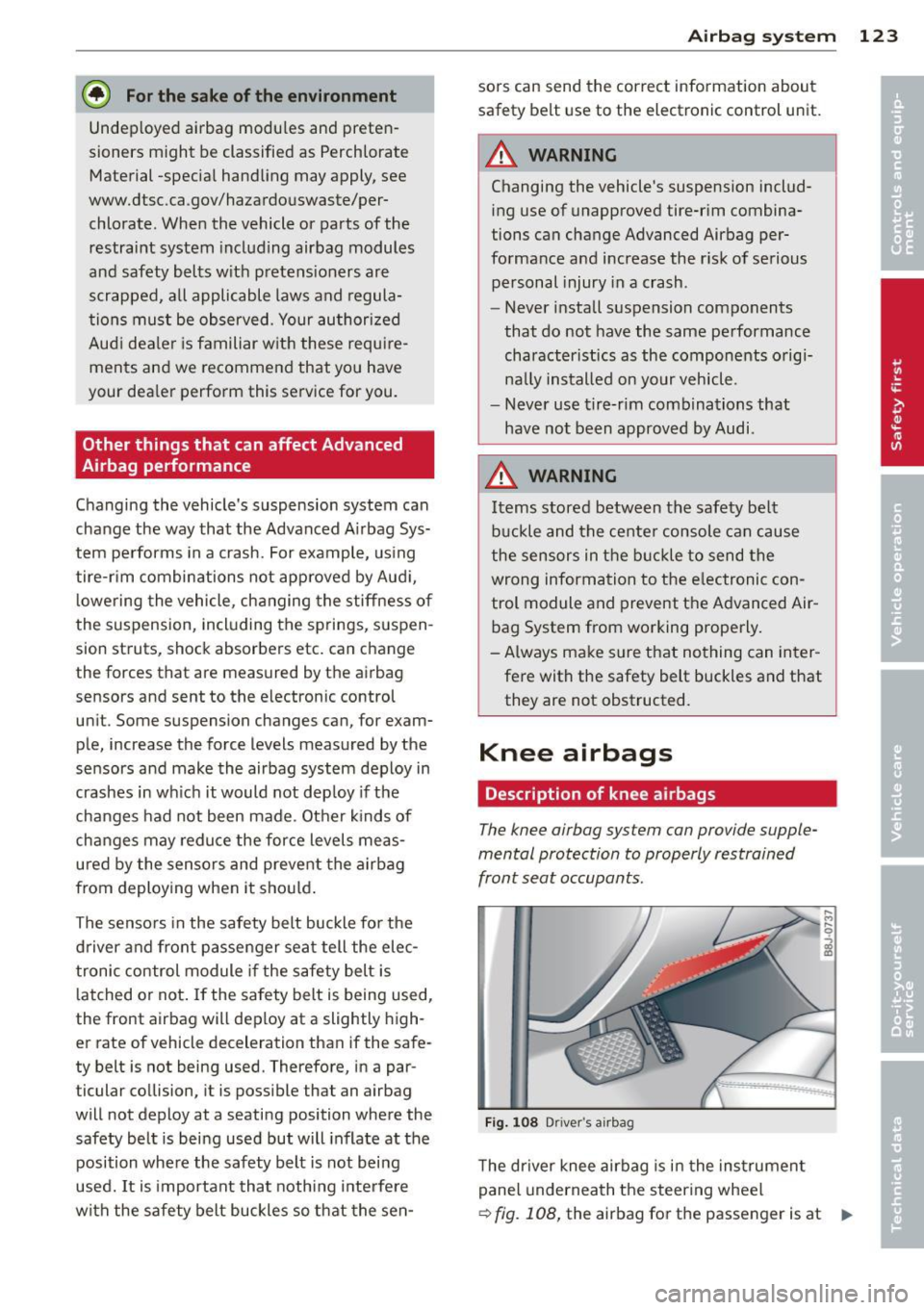
@ For the sake of the environment
Undeployed airbag modules and preten
sioners might be classified as Perchlorate
Material -special handling may apply, see
www.dtsc.ca .gov/hazardouswaste/per
chlorate. When the vehicle or parts of the
restraint system including airbag modules
and safety belts with pretensioners are
scrapped, all applicable laws and regula
tions must be observed. Your authorized
Audi dealer is familiar with these require
ments and we recommend that you have
your dealer perform this service for you.
Other things that can affect Advanced
Airbag performance
Changing the vehicle's suspension system can
change the way that the Advanced Airbag Sys
tem performs in a crash. For example, using
tire-rim combinations not approved by Audi,
lowering the vehicle, changing the stiffness of
the suspension, including the springs, suspen
sion struts, shock absorbers etc. can change
the forces that are measured by the airbag
sensors and sent to the electronic control
unit. Some suspension changes can, for exam
ple, increase the force levels measured by the
sensors and make the airbag system deploy in
crashes in which it would not deploy if the
changes had not been made. Other kinds of
changes may reduce the force levels meas
ured by the sensors and prevent the airbag
from deploying when it should.
The sensors in the safety belt buckle for the
driver and front passenger seat tell the elec
tronic control module if the safety belt is
latched or not. If the safety belt is being used,
the front airbag will deploy at a slightly high
er rate of vehicle deceleration than if the safe
ty belt is not being used. Therefore, in a par
ticular collision, it is possible that an airbag
will not deploy at a seating position where the safety belt is being used but will inflate at the
position where the safety belt is not being
used. It is important that nothing interfere
with the safety belt buckles so that the sen-
Airbag system 123
sors can send the correct information about
safety belt use to the electronic control unit.
A WARNING
Changing the vehicle's suspension includ
ing use of unapproved tire-rim combina
tions can change Advanced Airbag per
formance and increase the risk of serious personal injury in a crash.
- Never install suspension components
that do not have the same performance characteristics as the components origi
nally installed on your vehicle.
- Never use tire-rim combinations that
have not been approved by Audi.
A WARNING
-
Items stored between the safety belt
buckle and the center console can cause
the sensors in the buckle to send the
wrong information to the electronic con
trol module and prevent the Advanced Air
bag System from working properly.
- Always make sure that nothing can inter fere with the safety belt buckles and that
they are not obstructed.
Knee airbags
Description of knee a irbags
The knee airbag system can provide supple
mental protection to properly restrained
front seat occupants.
Fig. 108 Dr iver's airbag
The driver knee airbag is in the instrument
panel underneath the steering wheel
~ fig. 108, the airbag for the passenger is at Ill>
Page 129 of 262
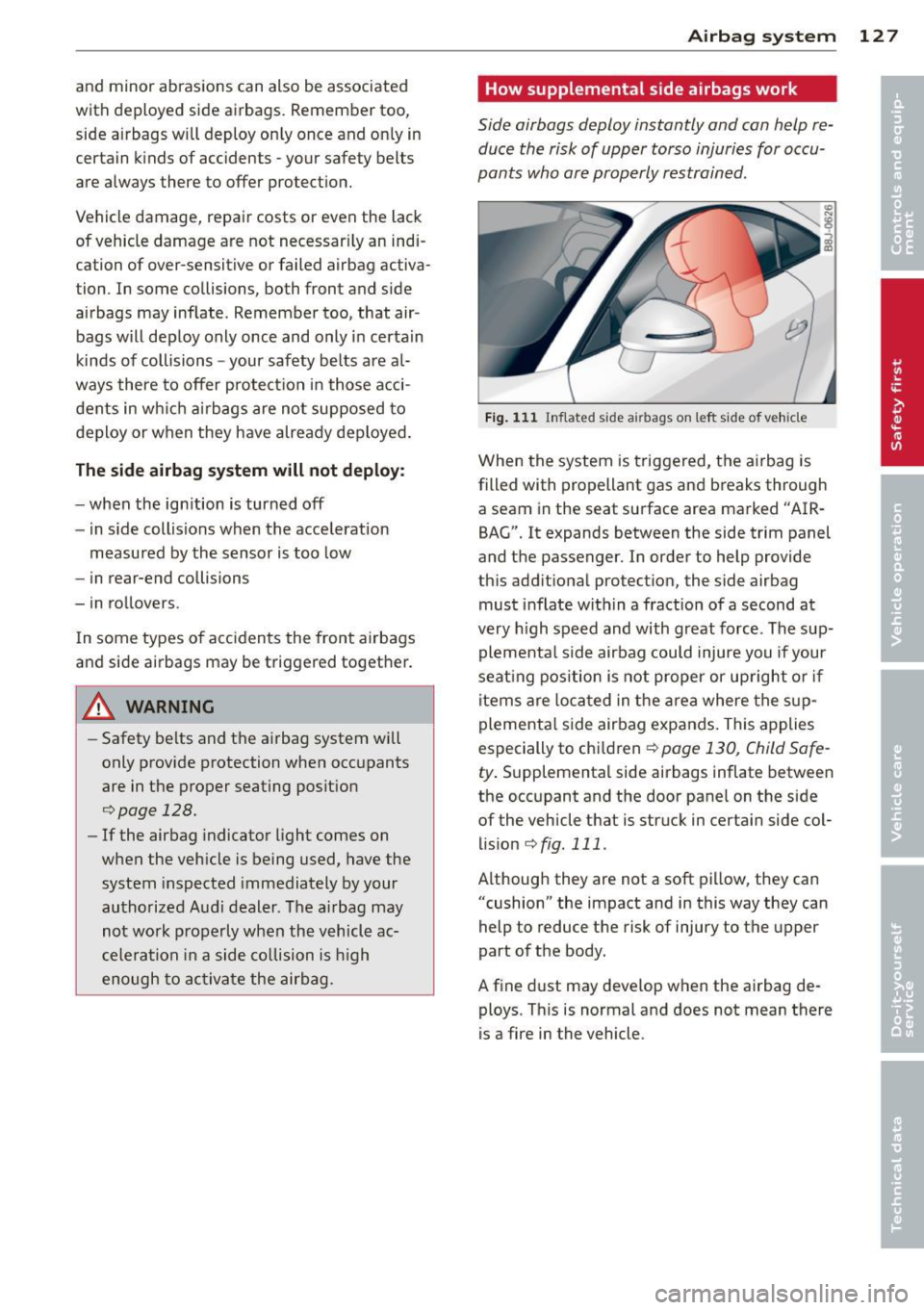
and minor abrasions can also be associated
with deployed side airbags. Remember too,
side airbags will deploy only once and only in
certain kinds of accidents -your safety belts
are always there to offer protect ion.
Vehicle damage, repair costs or even the lack
of vehicle damage are not necessar ily an indi
cation of over-sensitive or failed airbag activa
tion. In some collisions, both front and side
a irbags may inflate . Remember too, that air
bags will deploy only once and only in certain
kinds of collisions -your safety belts are al
ways there to offer protect ion in those acci
dents in wh ic h airbags are not supposed to
deploy or w hen they have already deployed .
The side airbag system will not depl oy :
- when the ignition is turned off
- in side collisions when the acceleration
measured by the sensor is too low
- in rear-end collisions
- in ro llovers.
I n some types o f acc idents the front airbags
and side airbags may be triggered together.
& WARNING
-Safety belts and the a irbag system will
only provide protection when occ upants
are in the proper seating posit ion
c') page 128.
- If the airbag indicator light comes on
when the vehicle is being used, have the
system inspected immediately by your
authorized Aud i dealer. The a irbag may
not wo rk p roperly when the vehicle ac
c ele ra tion in a side co llision is h igh
enough to ac tiva te the airbag.
.
A irba g sy stem 12 7
How supplemental side airbags work
Side airbags deploy instantly and can help re
duce the risk of upper torso injuries for occu
pants who are properly restrained.
F ig . 1 11 Inflated side airbags on left side of vehicle
i
When the system is triggered, t he a irbag is
filled with propellant gas and breaks through
a seam in the seat surface area ma rked
"AIR
BAG". It expands between the side trim panel
and the passenger. In order to help provide
th is add itiona l protection, the side airbag
must inflate within a fraction of a second at
very h igh speed and with great force. The sup
plementa l side airbag could injure you if your
seat ing pos ition is not proper or up right o r if
items are loca ted in the area where the s up
plementa l side airbag expands. This applies
especially to chi ldren ¢
page 130, Child Safe
ty .
Supplemental side airbags inflate between
the occupant and the door panel on the side
of the vehicle that is struck in certain side col
lis ion ¢
fig. 111.
Although they are not a soft pillow, they can
"cushion" the impact and in this way they can
help to reduce the risk of injury to the upper
part of the body.
A fine dust may develop when the airbag de
ploys . This is normal and does not mean there
is a fire in the vehicle.
Page 130 of 262
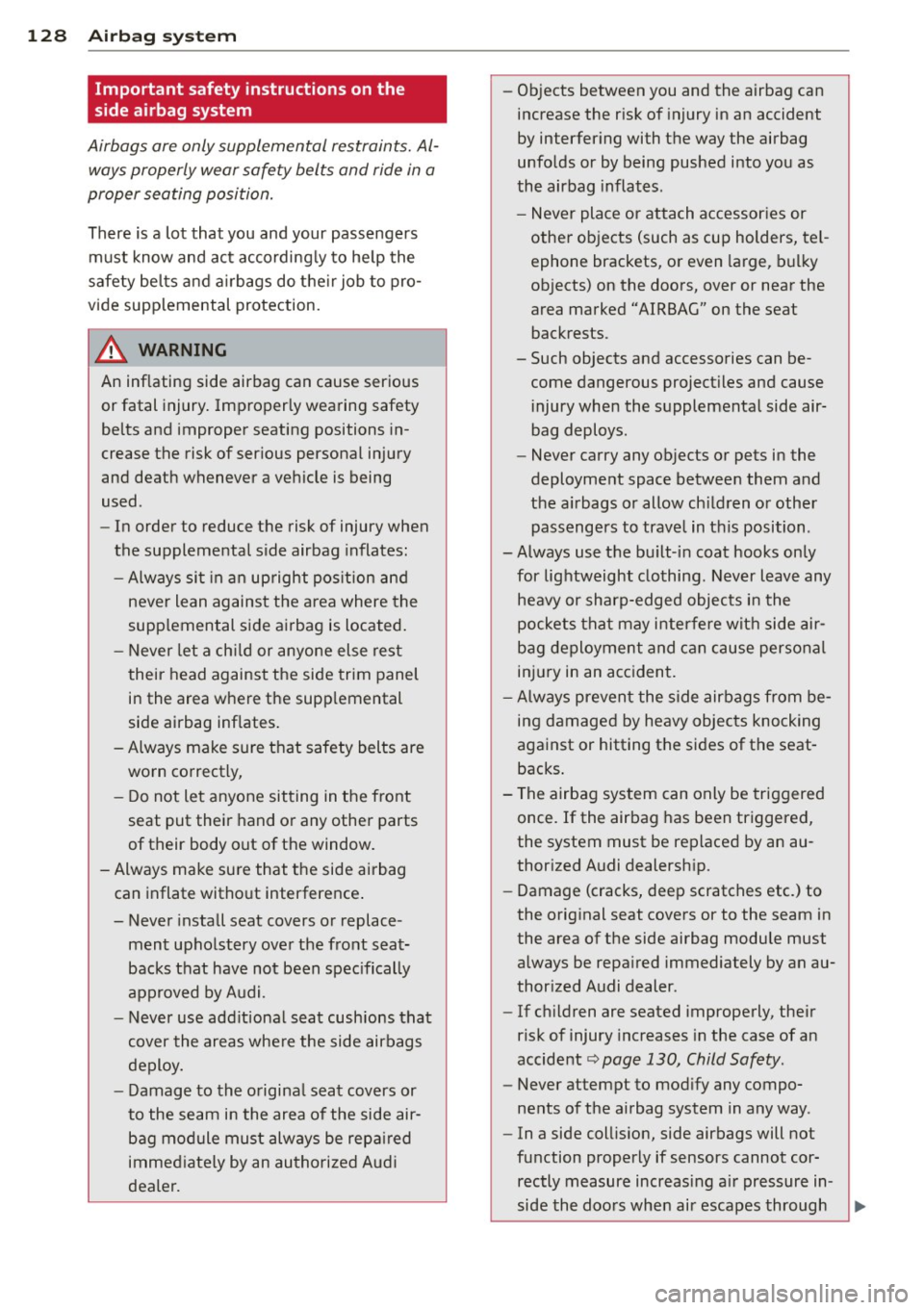
128 Airbag system
Important safety instructions on the
side airbag system
Airbags are only supplemental restraints. Al
ways properly wear safety belts and ride in a
proper seating position.
There is a lot that you and your passengers
must know and act accordingly to help the
safety belts and airbags do their job to pro
vide supplemental protection.
& WARNING
An inflating side airbag can cause serious
or fatal injury. Improperly wearing safety
belts and improper seating positions in
crease the risk of serious personal injury
and death whenever a vehicle is being
used.
- In order to reduce the risk of injury when
the supplemental side airbag inflates:
- Always sit in an upright position and
never lean against the area where the
supplemental side airbag is located.
- Never let a child or anyone else rest
their head against the side trim panel
in the area where the supplemental
side airbag inflates.
-Always make sure that safety belts are worn correctly,
- Do not let anyone sitting in the front
seat put their hand or any other parts
of their body out of the window.
-Always make sure that the side airbag can inflate without interference.
- Never install seat covers or replace
ment upholstery over the front seat
backs that have not been specifically
approved by Audi.
- Never use additional seat cushions that
cover the areas where the side airbags
deploy.
- Damage to the original seat covers or
to the seam in the area of the side air
bag module must always be repaired
immediately by an authorized Audi
dealer. -
Objects between you and the airbag can
increase the risk of injury in an accident
by interfering with the way the airbag
unfolds or by being pushed into you as
the airbag inflates.
- Never place or attach accessories or
other objects (such as cup holders, tel
ephone brackets, or even large, bulky
objects) on the doors, over or near the
area marked "AIRBAG" on the seat backrests.
- Such objects and accessories can be come dangerous projectiles and cause
injury when the supplemental side air
bag deploys.
- Never carry any objects or pets in the
deployment space between them and
the airbags or allow children or other passengers to travel in this position.
-Always use the built-in coat hooks only for lightweight clothing. Never leave any
heavy or sharp-edged objects in the
pockets that may interfere with side air
bag deployment and can cause personal
injury in an accident.
- Always prevent the side airbags from be
ing damaged by heavy objects knocking
against or hitting the sides of the seat
backs.
- The airbag system can only be triggered
once. If the airbag has been triggered,
the system must be replaced by an au
thorized Audi dealership.
- Damage (cracks, deep scratches etc.) to
the original seat covers or to the seam in
the area of the side airbag module must always be repaired immediately by an au
thorized Audi dealer.
- If children are seated improperly, their
risk of injury increases in the case of an
accident ~
page 130, Child Safety.
-Never attempt to modify any compo
nents of the airbag system in any way .
- In a side collision, side airbags will not
function properly if sensors cannot cor rectly measure increasing air pressure in-
side the doors when air escapes through ..,.
Page 133 of 262

-Always install rear-facing child safety
seats on the rear seat.
- If you must install a rearward facing
child safety seat on the front passenger
seat in exceptional circumstances and
the
PASSENGER AIR BAG OFF light does
not come on and stay on, immediately
install the rear-facing child safety seat in
a rear seating position and have the air
bag system inspected immediately by
your Audi dealer.
_& WARNING
If, in exceptional circumstances, you must
install a forward-facing child restraint on
the front passenger's seat:
- Always make sure the forward-facing
seat has been designed and certified by its manufacturer for use on a front seat
with a passenger front and side airbag.
- Always follow the manufacturer's in
structions provided with the child safety
seat or carrier.
- Always move the passenger seat into its
rearmost position in the seat's fore and
aft adjustment range, as far away from
the airbag as possible before installing
the child restraint. The backrest must be adjusted to an upright position .
- Always make sure that the
PASSENGER
AIR BAG OFF
light comes on and stays
on all the time whenever the ignition is
switched on.
(D Tips
Always replace child restraints that were
installed in a vehicle during a crash. Dam
age to a child restraint that is not visible
could cause it to fail in another collision
situation.
Advanced front airbag system and children
Your vehicle is equipped with an "Advanced
Airbag System" in compliance with United
States Federal Motor Vehicle Safety Standard
Child Safety 131
(FMVSS) 208 as applicable at the time your
vehicle was manufactured.
The Advanced Airbag system in your vehicle
has been certified to meet the "low-risk" re
quirements for 3- and 6-year old children on
the passenger side and small adults on the driver side. The low risk deployment criteria
are intended to reduce the risk of injury
through interaction with the airbag that can
occur, for example, by being too close to the
steering wheel and instrument panel when
the airbag inflates . In addition, the system
has been certified to comply with the "sup
pression" requirements of the Safety Stand
ard, to turn off the front airbag for infants up
to 12 months who are restrained on the front
passenger seat in child restraints that are list
ed in the Standard.
Even though your vehicle is equipped with an
Advanced Airbag system, all children, espe cially those 12 years and younger, should al
ways ride in the back seat properly restrained
for their age and si ze. The airbag on the pas
senger side makes the front seat a potentially dangerous place for a child to ride . The front
seat is not the safest place for a child in a for
ward-facing child safety seat. It can be a very
dangerous place for an infant or a larger child
in a rearward-facing seat .
Advanced Airbags and the weight
sensing mat in the front seat
The Advanced Airbag System in your vehicle
detects the presence of an infant or child in a
child restraint on the front passenger seat us
ing the weight -sensing mat in the seat cush
ion and the sensor below the safety belt latch
on the front passenger seat that measures the
tension on the safety belt.
The weight -sensing mat measures total
weight of the child and the child safety seat
and a child blanket on the front passenger seat. The weight on the front passenger seat
is related to the design of the child restraint
and its "footprint", the size and shape of the
bottom of the child restraint as it sits on the ..,.
•
•